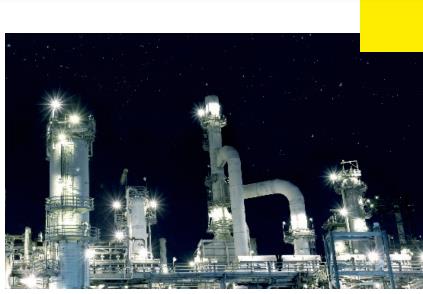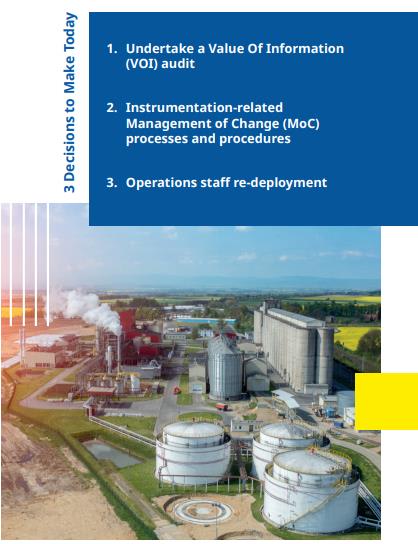 Immunize Plant Instrumentation Against Uncertainty
Immunize Plant Instrumentation Against Uncertainty
What cannot and is not measured, cannot be improved. Any data-driven approach for continuous improvement in manufacturing requires definition, ongoing tracking, and reporting of key performance indicators (KPIs) against targets.
This is as relevant in the boardroom with management as it is on the shop floor with the field instruments and systems that enable highly precise measurement, data acquisition, and analysis. What is the point in providing the tools and applications to steward manufacturing operations conformance against targets and constraints if the basic means are not first in place to measure the operation for situational awareness?
Changing Times
 What was fit-for-purpose then is no longer. An added challenge is that many facilities were built at a time – some as far back as the 70s and 80s – for a particular process, a certain level of control, and a certain suite of optimization applications.
What was fit-for-purpose then is no longer. An added challenge is that many facilities were built at a time – some as far back as the 70s and 80s – for a particular process, a certain level of control, and a certain suite of optimization applications.
Today the world grapples with the impacts of the uncertainty. These facilities are now operated and maintained at skeleton staffing levels, retooled for a different service level than originally intended and designed. Operating envelopes are changing and the impact of these changes on field instrumentation must not be underestimated.
Instrumentation with a design rating of a particular flow rate or capacity is stressed heavily when the service or load is increased substantially. In some cases, the instrumentation for the original service is unsuitable for the new service and must be swapped out. This is typically the case for low-grade instrumentation that does not have the resilience of higher quality devices that can be re-purposed for the new service/ operating envelope.
Some fine and specialty chemicals manufacturers may be dosing new chemicals into flowlines for enhanced process efficiency or to eliminate emulsions and hydrates. For legacy instrumentation, this can be a real issue as it affects the effectiveness of the instrumentation resulting in periods of time when the plant is subject to sub-par control. This can impact plant safety and reliability, as well as profitability; profitability can be impacted significantly because the product on the backend of the process is either burned (e.g. erroneous temperature measurement) or the material produced is off-spec.
Newer field instruments that have been designed to retrofit well into existing infrastructure can handle these situations much better.
Key plant measurement device/data considerations. Situational awareness forms the basis of effective decision-making in process facilities. The foundation for situational awareness is the plant data itself, gathered from the various devices on the front line. With context and relationship, plant process data measurements constitute information.
Increasing context, connectedness and patterns/relationships, and the understanding thereof, can then lead to knowledge and insight. This knowledge and insight are fundamental to effective decision-making in plant operations, which is made easier through data analytics, which itself is underpinned by the quality of the fundamental plant data. Only with robust plant data can the true potential of analytics be realized.
For facilities to be safe, responsive, and adaptive, plant data management can no longer be viewed as an after-thought or down the pecking order in terms of the plant management hierarchy. Key plant measurement device/data considerations include:
 Measurement Device/ Data Governance
Measurement Device/ Data Governance
- Is there an ownership record for each device/data point?
- Is there an audit trail of changes?
- Where devices/data are replaced or over-written, what happens to applications that used old values? How are the discrepancies between old and new values handled? Are applications properly tested to ensure the validity of source data?
- Are security arrangements in place to allow appropriate exposure of data within the organization, yet limit the risk of exposure externally?
Measurement Device/Data Propagation
- When a change is made in the field, how does the system of records know about it?
- Which devices and applications are affected by these changes?
- Are the affected devices designed and tested to cope with said changes?
Measurement Device/Data Dufficiency
- Are all necessary values being collected?
- Is there sufficient coverage of the process/asset?
- Is there sufficient measurement intensity/frequency?
- Does the level of redundancy meet the level of criticality of the application?
Measurement Device/Data Trust
- Are instruments of adequate accuracy and reliability for their intended application(s)?
- How does turndown affect instrument performance when operating outside of standard conditions?
- What is the impact of saturation
- or process spikes?
- How resilient are instruments to changing ambient conditions such as temperature, vibration, EMI, etc…?
- Should consider a new frequency for measurement validation?
- Are there new/different compliance requirements?
Three Decisions to Make Today
1. Undertake a Value Of Information (VOI) audit
Knowledge and information are useless unless the organization is going to do something with it. While an excess of process data presents many opportunities, it can also paralyze an organization and hinder the speed of decision-making. It can also cost a lot to gather and maintain. Since the value of information varies depending on particular circumstances and strategic priorities, which information sources matter the most in the plant? Evaluate the key value drivers of the plant. Assess what plant data and information is required by relevant applications and personnel to create value. Inventory the key devices/instrumentation needed to ensure value creation can be sustained.
2. Instrumentation-related Management of Change (MoC) processes and procedures
 Quality measurements must be maintained when switching between plant production levels, product line batches, or with other plant configuration changes as these stress instrumentation devices in different ways. Assign responsibility to an individual within the instrumentation discipline to work with operations for creating or updating formal MoC processes and procedures for key plant measurement/data considerations. Based on this, establish a fleet-wide measurement device monitoring and assurance program. All devices should have a purpose, goals and target performance to achieve, constraints, and limits to respect. Some are explicit and some are implicit; some are simple to measure, and some are derived from complex chemistry, physics and math; some are static, and some are dynamic; some are constant, and some are conditional. A well-managed operation will know what these are, will document why they are needed and the consequences of non-conformance, and will have personnel accountable for compliance. A fleet-wide system for tracking and reporting performance, as well as assuring compliance is a necessary first step to operational improvement.
Quality measurements must be maintained when switching between plant production levels, product line batches, or with other plant configuration changes as these stress instrumentation devices in different ways. Assign responsibility to an individual within the instrumentation discipline to work with operations for creating or updating formal MoC processes and procedures for key plant measurement/data considerations. Based on this, establish a fleet-wide measurement device monitoring and assurance program. All devices should have a purpose, goals and target performance to achieve, constraints, and limits to respect. Some are explicit and some are implicit; some are simple to measure, and some are derived from complex chemistry, physics and math; some are static, and some are dynamic; some are constant, and some are conditional. A well-managed operation will know what these are, will document why they are needed and the consequences of non-conformance, and will have personnel accountable for compliance. A fleet-wide system for tracking and reporting performance, as well as assuring compliance is a necessary first step to operational improvement.
3. Operations staff re-deployment
Where unit operations have been turned down or temporarily shuttered, can operators be re-deployed to support re-instrumentation in locations that lack adequate coverage? For example, regular and accurate pressure measurements and flowrates at either end (top and bottom) of impulse lines on distillation columns are vital for a reasonably accurate mass balance to be achieved in order to match models to plant data. After all, many analytics and rigorous dynamic models use on-line measurements from the plant to provide information about the status of the plant which cannot be directly measured, can predict the future trajectory of the plant, and can advise the operators about action required to keep the plant within its operating window and at its optimum operating point. However, accessing these measurement locations isn’t always straightforward. Downtime of operations staff could be utilized to find sustainable solutions for these challenges for when operations ramp up again, in order to find ways to retrofit, upgrade, or maintain measurements across the plant.
Industries
-
Chemical
Chemical plants rely on continuous and batch production processes, each posing different requirements for a control system. A continuous process calls for a robust and stable control system that will not fail and cause the shutdown of a production line, whereas the emphasis with a batch process is on having a control system that allows great flexibility in making adjustments to formulas, procedures, and the like. Both kinds of systems need to be managed in available quality history of product, and to be able to execute non-routine operations. With its extensive product portfolio, experienced systems engineers, and global sales and service network, Yokogawa has a solution for every plant process.
-
Oil & Gas
Yokogawa has a wealth of experience in every part of the oil and gas business, from offshore and onshore facilities to pipelines, terminals, and deepwater operations. We provide solutions that enhance safety, ensure accurate and reliable operation, and increase plant efficiency.